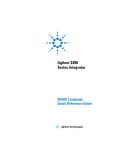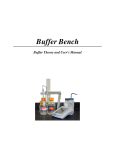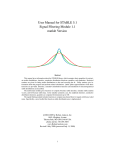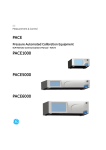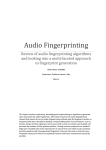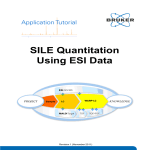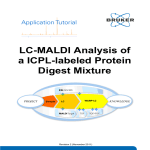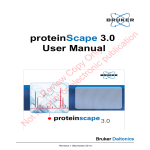Download ProCon User Manual 0.9.619 - Ruhr
Transcript
ProCon© (Proteomics Conversion Tool) User Manual Monday, December 14, 2015 ProCon – Proteomics Conversion Tool ProCon – Proteomics Conversion Tool ...................................................................................1 1 Introduction .........................................................................................................................2 2 Installation ...........................................................................................................................2 3 General Configuration .........................................................................................................4 File ./config/ProCon.properties ...........................................................................................4 File ./config/log4j.properties: ..............................................................................................4 4 Start ProCon ........................................................................................................................5 5 Workflow 1: Sequest.out / comet.out Import and mzIdentML export ...................................6 5.1 Sequest-specific Configuration .....................................................................................6 The SEQUEST converter converts the .out files from an arbitrary folder into the mzIdentML format. Besides the .out (and .dta files) the folder must contain the following 2 (for comet.out) resp. 4 (for SEQUEST.out) files: .........................................................6 ·Header.txt only for SEQUEST.out; not required for comet.out conversions.................6 ·sequest.log only for SEQUEST.out; not required for comet.out conversions ...............6 ·sequest.params resp. comet.params ................................................................................6 ·<folder-name>.log, e.g. if your folder is named 'test_folder' then the file should be named 'test_folder.log' ....................................................................................................6 4.1.1 File ./config/SEQUEST_massvalues.txt .................................................................8 4.1.2 File ./config/SEQUESTMOD.obo ..........................................................................8 4.1.3 File ./config/unimod.obo ........................................................................................9 4.1.4 File ./config/Sequest.properties ..............................................................................9 4.1.5 File ./config/mzidAuditCollection_1.1.xml ............................................................9 6 Workflow 2: ProteinScape® 1.3 Import and PRIDE XML export .......................................11 6.1 Prerequisites ...............................................................................................................11 Connection to your local ProteinScape® database ..........................................................11 Data for First Test .........................................................................................................11 Connection to Ontology Lookup Service.......................................................................11 6.2 ProteinScape®-specific Configuration .........................................................................12 File ./config/PAG-PS.obo .............................................................................................12 File ProteinScape.properties ..........................................................................................12 6.3 ProteinScape® Data Generation ...................................................................................13 6.4 Testing / Initializing the Database Connection ............................................................13 Medical Proteome Center (MPC), University of Bochum, 2015 1 / 30 ProCon© (Proteomics Conversion Tool) User Manual Monday, December 14, 2015 6.5 Converting a Search Event ..........................................................................................14 6.6 Converting Gel Data ...................................................................................................14 6.7 Instrument information and References .......................................................................15 6.8 Missing Information....................................................................................................15 7 Workflow 3: Proteome Discoverer® to mzIdentML conversion..........................................17 8 Workflow 4: ProteinScape® 2.1 to mzIdentML conversion ................................................20 9 Workflow 5: Spectral Counts to mzQuantML conversion ..................................................22 10 Tools menu ......................................................................................................................23 11 Command Line Arguments for batch mode ......................................................................23 12 Versioning Information and Release Notes ......................................................................27 13 How to cite ......................................................................................................................28 14 Known Bugs ....................................................................................................................28 15 Planned future functionality .............................................................................................29 16 Acknowledgements .........................................................................................................29 17 References .......................................................................................................................30 1 Introduction With ProCon you can convert proteomics identification and quantification results into HUPO standard formats [1], which can be used to upload your results into public repositories. 2 Installation Install Java SE (JRE): ProCon was tested with JRE 8, Update 66, 64 Bit, but should work with all former JRE 7 and newer JRE 8 versions, e.g. from the actual download version here: http://www.oracle.com/technetwork/java/javase/downloads/index.html. ! Installation of a new ProCon release: ! If you have already used ProCon and install a new release be sure to “save” any changes made to .config files (e.g. added modifications, institute address or server information). Then unzip ProCon_dist<version>.zip into an arbitrary directory, e.g. C:\ProCon. This is the so-called working directory, from which you start ProCon later (see below). Verify (and potentially change) the configuration files (see next section and configuration subsections in “Sequest .out Import ...” and “ProteinScape® 1.3 Import ...” sections). Medical Proteome Center (MPC), University of Bochum, 2015 2 / 30 ProCon© (Proteomics Conversion Tool) User Manual Monday, December 14, 2015 The ProteomeDiscoverer version now supports both an access to the SQLite database (.msf file) via JDBC and via a native interface (sqlite4java) written in C++. It’s recommended to use the JDBC version, which uses the driver from https://bitbucket.org/xerial/sqlite-jdbc. If one wants to use the native interface instead, one first must install the operating system specific files for sqlite4java from the website http://code.google.com/p/sqlite4java/ . For Windows® operating systems copy the DLL’s sqlite4java-win32-x64.dll resp. sqlite4javawin32-x86.dll into the folder C:\Windows\SysWOW64 resp. C:\Windows\System32. Also sqlite3.dll available from http://www.sqlite.org/ should be copied into the proper system directory (C:\Windows\System32). (Note that at moment only a sqlite3.dll for 32 Bit is available). Then in the batch file start_ProCon.bat set the JAVA_HOME variable to point to your Java Runtime Environment (JRE). For Mac OS X® resp. Linux operating systems one should install the files *.dylib resp. *.so from the sqlite4java distribution into the respective system directories. For starting ProCon you should first set the path to your Java runtime installation in the batch file start_ProCon_from_GUI.bat and then right click on this batch file and run it. @echo on set JAVA_HOME="C:\Program Files\Java\jre1.8.0_66\bin\java.exe" %JAVA_HOME% -jar ProCon.jar pause Medical Proteome Center (MPC), University of Bochum, 2015 3 / 30 ProCon© (Proteomics Conversion Tool) User Manual Monday, December 14, 2015 3 General Configuration File ./config/ProCon.properties Specify the details of the person(s) responsible for the mass spectrometry of the sample measured and the “MassSpecInstitution=”, data set (probably you) (i.e. “MassSpecEMailPhoneFax=”, “MassSpecContactName=”, “DataSetContactName=”, “DataSetInstitution=”, “DataSetEMailPhoneFax=”; fill-in directly after the “=”). These details are for example used in the “ProteinScape® 1.3 to PRIDE XML” conversion. File ./config/log4j.properties: Lines log4j.appender.ProCon_file.File and log4j.appender.pride_core_file.File should contain \\ as path separator for Windows and / for Unix-based operating systems. Medical Proteome Center (MPC), University of Bochum, 2015 4 / 30 ProCon© (Proteomics Conversion Tool) User Manual Monday, December 14, 2015 4 Start ProCon Start the ProCon.jar by double-clicking it or by giving the command java –jar ProCon.jar (ensure, that it starts in the working directory, where you unzipped it; more exactly the directory with subfolders /config, /instruments, /XML_files, ...). ProCon now runs with both the Java 7 and Java 8 runtime. The example batch file start_ProCon.bat shows how one can set Java Runtime options. Any firewall message or any question of a protection tool about “an application start” should be confirmed / allowed. In case ProCon does not start check the contents of the log file in the log folder: .\log\ProCon.txt. More detailed information about errors can be found in the log files in the ./log folder (ProCon.log for ProCon, ProteinScape® and Sequest classes and pride.log for pride classes). There are four workflows you can follow in the current version: 1) Import of Sequest .out files and export to mzIdentML [2] 2) ProteinScape® 1.3 import and PRIDE XML export 3) Proteome Discoverer® 1.1, 1.2 and 1.3 to mzIdentML 1.1 conversion, 4) ProteinScape® 2.1 to mzIdentML 1.1 conversion. 5) Spectral counts to mzQuantML [3] conversion. Medical Proteome Center (MPC), University of Bochum, 2015 5 / 30 ProCon© (Proteomics Conversion Tool) User Manual Monday, December 14, 2015 5 Workflow 1: Sequest.out / comet.out Import and mzIdentML export Functionality has been added for import of a Sequest out folder (one search engine run) and export of this Sequest data set to mzIdentML. Use the tab Sequest.out / comet.out to mzIdentML for export. Sequest import was tested with Bioworks Sequest (version 3.2). Comet import was tested with Comet (version 2015.01 rev. 1) Because this implementation is important to establish the mzIdentML standard, please report all errors and suggestions to the ProCon developers specified on http://www.medizinischesproteom-center.de/software. 5.1 Sequest-specific Configuration The SEQUEST converter converts the .out files from an arbitrary folder into the mzIdentML format. Besides the .out (and .dta files) the folder must contain the following 2 (for comet.out) resp. 4 (for SEQUEST.out) files: ·Header.txt only for SEQUEST.out; not required for comet.out conversions ·sequest.log only for SEQUEST.out; not required for comet.out conversions ·sequest.params resp. comet.params ·<folder-name>.log, e.g. if your folder is named 'test_folder' then the file should be named 'test_folder.log' If you don’t find this information in your SEQUEST folder containing the .out files, then you have to create the content of these files by your own using any text editor according to the following description: a) Header.txt: (only for SEQUEST.out; not required for comet.out conversions) Sample LastName e.g. LastName:Joppich Sample:PMXPWE080620_38 b) sequest.log: (only for SEQUEST.out; not required for comet.out conversions) TurboSEQUEST - xxxxxxxxxxxxxxx ... // (xxxxxxxxxxxxxxx = SEQUEST version) Medical Proteome Center (MPC), University of Bochum, 2015 6 / 30 ProCon© (Proteomics Conversion Tool) User Manual Monday, December 14, 2015 e.g. TurboSEQUEST - PVM Master v.27 (rev. 12), (c) 1998-2007 c) sequest.params: (in case of SEQUEST.out conversion) diff_search_options term_diff_search_options database_name first_database_name second_database_name mass_type_parent mass_type_fragment max_num_internal_cleavage_sites peptide_mass_tolerance peptide_mass_units fragment_ion_tolerance enzyme_info e.g. diff_search_options = 15.9949 M 57.0 C 0.000 X 0.000 X 0.000 X 0.000 X term_diff_search_options = 0.0000 0.0000 database_name = D:/Database/StdCry.fasta first_database_name = D:/Database/StdCry.fasta second_database_name = mass_type_parent = 0 // 0=average masses, 1=monoisotopic masses mass_type_fragment = 1 // 0=average masses, 1=monoisotopic masses max_num_internal_cleavage_sites = 5 // maximum value is 5 peptide_mass_tolerance = 1.5000 peptide_mass_units = 0 // 0=amu, 1=mmu, 2=ppm fragment_ion_tolerance = 1.5000 // width in amu of bins for fragment ions enzyme_info = Trypsin 1 1 KR – c) comet.params: (in case of comet.out conversion) e.g. … search_enzyme_number = 1 # choose from list at end of this params file Medical Proteome Center (MPC), University of Bochum, 2015 7 / 30 ProCon© (Proteomics Conversion Tool) User Manual num_enzyme_termini = 2 Monday, December 14, 2015 # valid values are 1 (semi-digested), 2 (fully digested, default), 8 N-term, 9 C-term … fragment_bin_tol = 1.0005 # binning to use on fragment ions … output_outfiles = 1 # 0=no, 1=yes write .out files … d) <folder-name>.log: Sequest queued xxxxxxxxxxxxxxxxxxxxxxxxx ... // (xxxxxxxxxxxxxxxxxxxxxxxxx = activity date in the format "EEE MMM dd kk:mm:ss: yyyy") e.g. Sequest queued Tue Jun 24 11:32:27 2008 StdCry_nr.fasta Trypsin 15.99491 M 57.0000 C 0.0000 X 0.0000 X 0.0000 X 0.0000 X mods 0.0000 0.0000 cj 4.1.1 File ./config/SEQUEST_massvalues.txt This config file contains the mass values Sequest uses. Be sure to use the mass value file of your Sequest installation! (Server path e.g. C:\Inetpub\etc\config.) 4.1.2 File ./config/SEQUESTMOD.obo Sequest uses only masses for modifications. In the Sequest .obo file a mapping between these masses (added to an amino acid) have to be mapped to UNIMOD modifications (used in mzIdentML). If you used a “modification mass / amino acid” not specified, an error occurs during export. The edit the .obo file and add this new combination in the following form: Example: Oxidation (here with mass 15.9949) of Methionine. [Term] id: SEQMOD:00002 name: M+15.9949 def: "Oxidation of Methionine" [UNIMOD:UNIMOD\:35] Medical Proteome Center (MPC), University of Bochum, 2015 8 / 30 ProCon© (Proteomics Conversion Tool) User Manual Monday, December 14, 2015 is_a: SEQMOD:00001 ! Modification Be aware, that in Sequest fixed and variable modifications are specified separately and can therefore have different masses (e.g. different number of decimals). 4.1.3 File ./config/unimod.obo This is just the unimod.obo file from http://www.unimod.org/obo/unimod.obo. The unimod.obo file coming with ProCon should be sufficient for most cases. Overwrite with the latest version (date stamp inside the file) to be up-to-date. 4.1.4 File ./config/Sequest.properties The mzIdentML output contains a globally unique Sequest server URI to specify the location of some files (e.g. the search database file) This URI is not necessarily a browsable web address! In the Sequest.properties file specify the URL part and the name of your Sequest server. Example: URISequestServerURL=www.medizinisches-proteom-center.de URISequestServerName=sequestmaster This will lead to the following URI for the search database in the mzIdentML file: file://www.medizinisches-proteomcenter.de/sequestmaster/work/Datenbank/StdCry_nr.fasta 4.1.5 File ./config/mzidAuditCollection_1.1.xml For export of mzIdentML a Provider contact role (e.g. “researcher”) and the Provider’s organization (e.g. institute within a university) should be specified. The mzidAuditCollection_1.1.xml .config file contains this information using a certain structure (similar to FuGE). Please overwrite with your details! You should not change the sequence of comment and content lines. If you accidently destroy the file, copy over with mzidAuditCollectionTemplate_1.1.xml. If you use the “Sequest .out to mzIdentML_1.0” export (deprecated!), use the mzidAuditCollection_1.0.xml file analogously. Medical Proteome Center (MPC), University of Bochum, 2015 9 / 30 ProCon© (Proteomics Conversion Tool) User Manual Medical Proteome Center (MPC), University of Bochum, 2015 Monday, December 14, 2015 10 / 30 ProCon© (Proteomics Conversion Tool) User Manual Monday, December 14, 2015 6 Workflow 2: ProteinScape® 1.3 Import and PRIDE XML export 6.1 Prerequisites Connection to your local ProteinScape® database ProCon connects to the SQL database of your PS 1.3 installation. The SQL database must be configured to allow connections via TCP/IP (default port 1433). A connection string is implemented like: jdbc:jtds:sqlserver://<IP_address_of_server>:1433/ProteinScape1_0; user=<username>;password=<password> Therefore you must know: - the IP address of the ProteinScape® server (where the SQL database is normally installed, too) - the port of the SQL database (default 1433 for Microsoft SQL Server) - no firewall should prevent the communication between the computer where ProCon runs and the database server - the database name (default:ProteinScape1_0) - the SQL user name (we can use sa because ProCon does not CHANGE anything, but you may create another user having only read permissions) - the SQL password for this database user Data for First Test ProCon was tested for 2D gels and 1D-LC, both PMF (MS) or PFF (MS/MS), either protein assembly by search engine or by ProteinExtractor. It was tested with Mascot, Sequest and Phenyx runs. A best (because simplest) first test would be a LC/MS/MS run performed using one search engine. Connection to Ontology Lookup Service During import of ProteinScape® experiments, the taxonomy ID is queried online using the Ontology Lookup Service at the European Bioinformatics Institute (http://www.ebi.ac.uk/ontology-lookup/services/OntologyQuery). That works correctly only, Medical Proteome Center (MPC), University of Bochum, 2015 11 / 30 ProCon© (Proteomics Conversion Tool) User Manual Monday, December 14, 2015 if ProCon (as Java application) can establish an online connection at runtime. You should configure firewall rules appropriately or answer firewall questions with Yes. 6.2 ProteinScape®-specific Configuration File ./config/PAG-PS.obo In this file the mapping from ProteinScape® modifications to PSI-MOD is configured. As it is “name-based” there may exist differences in your ProteinScape® installation. This is most probable for modifications you added yourself (e.g. “Cy3” differs from “Cy3 (C)”!) You should check your commonly used modifications (names and at least one cross-reference to PSI-MOD) before using ProCon the first time. ProCon looks for "names", so you must be quite exact considering each space and bracket. Whenever an unknown modification is encountered during import, ProCon aborts and displays an info message to correct the .obo file. File ProteinScape.properties The property ENDIAN_TYPE allows specification of base64 encoding of mzdata binary arrays (“little” or “big”). Precision is fixed to 64 (double). Only necessary, if Mascot was used in the analyses, that are to be exported: “SATParameterType” should be the ParameterType in the SearchAlgorithmTranslations table for instrument mappings (default: 8). You can check, whether 8 is okay for you, if the SQL query: select distinct AlgorithmName from SearchAlgorithmTranslations where ParameterType=8 on the ProteinScape® database results in some Mascot instruments like: ESI-FTICR ESI-QUAD-TOF ESI-TRAP ESI-TRAP,ETD-TRAP,ESI-TRAP MALDI-QTOF MALDI-TOF-TOF Medical Proteome Center (MPC), University of Bochum, 2015 12 / 30 ProCon© (Proteomics Conversion Tool) User Manual Monday, December 14, 2015 6.3 ProteinScape® Data Generation In order to obtain concise and complete result files, you should follow some guidelines in ProteinScape® data generation: - Fill in all fields for to describe project, sample, separation and spot/band (nearly all fields are exported, if not as CVParam [4,5], then as userParam); o AVOID empty fields or “default” or “not specified” fields; o wrong descriptions go non-validated into the exported XML! - Use one instrument type for each imported spectrum (or each spectrum package, called “combined spectrum”); otherwise the results cannot be exported into the same <Experiment> element, but have to go into separate data sets. - Use one SearchMethod for all identification runs of a gel (not only the same name, but really the same method having the same SearchMethodID); otherwise the results cannot be exported into the same <Experiment> element, but have to go into separate data sets. 6.4 Testing / Initializing the Database Connection A default database connection string is given on the ProteinScape® Source tab (which can be anytime restored by clicking the Reset DB string button). Provide the correct information for your server as described in section 1 (see above). Example: jdbc:jtds:sqlserver://134.147.123.124:1433/ProteinScape1_0;user=iu ser;password=iuser Before you can import ProteinScape® data, you have to click the Initialize DB Connection: button. Please be patient, this can take some time! ProCon tries to connect to the ProteinScape® server and database with the specified account information. If an error occurs, the error/exception text is printed out. Check the connection string and try Initialize DB Connection: again. If no error occurs, you will find three project names of your ProteinScape® server in the text area next to the button. Only if you see these project names, the connection is working! Otherwise contact the ProCon developers specified on http://www.medizinisches-proteomcenter.de/ProCon. Medical Proteome Center (MPC), University of Bochum, 2015 13 / 30 ProCon© (Proteomics Conversion Tool) User Manual Monday, December 14, 2015 6.5 Converting a Search Event • Specify a SearchEventID on the ProteinScape® Source tab and click the Import ProteinScape® SearchEvent button. ProCon imports the proteins marked green, their peptides (with modifications) and the spectra in which those have been identified. During the import ProCon asks you to specify any missing information (see section “Missing Information” below). Please be patient, the import may take some time (scroll-down the Outputs text area for latest progress messages)! Further ProteinScape® data sets can be imported, or the current imports can be cleared. • Then on the PRIDE XML tab click the Assemble PRIDE XML button and a PRIDE data set is assembled internally (subsequent imports can be added to this assembly, or the current assembly can be cleared). • Finally click Export to PRIDE XML file and the current data sets currently in the PRIDE assembly are exported to the PRIDE XML file specified in the text field of this tab. 6.6 Converting Gel Data • On the ProteinScapeSource tab there is a ComboBox containing all separations of your server (entries are structured “<project> | <sample> | <gel> (<GelID>)”, long names are truncated, GelID is unique!). Specify a separation and click the Import ProteinScape Separation button. ProCon then considers all spots, spectra and searches of this separation and exports the proteins marked green, their peptides (with modifications) and the spectra in which those have been identified. Dependent on the selection status of the PMF / PFF check boxes, PMF and/or PFF identifications are exported (leading to 1 or 2 ProteinScape® imports). During the import ProCon asks you to specify any missing information (see section “Missing Information” below). • PRIDE can only describe one protocol per data set (i.e. per <Experiment> element). If the SearchEvents of the specified gel have been run with different SearchMethods, ProCon asks you to select one. Only SearchEvents done with this SearchMethod are then imported. ATTENTION: In ProteinScape®, if you modify a SearchMethod and run a SearchEvent without saving the method changes, it is not stored but the SearchEvent is named "origSearchMethod(modified)" per default. If you anyhow store and then select such a SearchMethod (with the “(modified)” postfix), ProCon will export only last SearchEvent, although there may be more SearchEvents using the same (default) name. RECOMMENDATION: You should optimize a SearchMethod Medical Proteome Center (MPC), University of Bochum, 2015 14 / 30 ProCon© (Proteomics Conversion Tool) User Manual Monday, December 14, 2015 for your gel, then store it and run all SearchEvents for a gel you want to export with the same stored SearchMethod. • Please be patient, the import may take some time (scroll-down the Outputs text area for latest progress messages)! • Then click the Assemble PRIDE XML button and a PRIDE data set is assembled internally (containing 1 or 2 experiments in PRIDE assembly, depending on PMF and/or PFF identifications in the gel). • Finally click Export to File and the current PRIDE data set is exported to the file specified in the text field of this tab. Subsequently imported ProteinScape® imports are added to the internally assembled PRIDE data set and can be flushed out together using Export to File. 6.7 Instrument information and References On the General Source tab, instrument details and references can be imported. During PRIDE XML export, the respective sections (mzData/instrument and <Reference> elements) are overwritten / filled with the imported information in all data sets of the assembly. 6.8 Missing Information Depending on the information or type of results you want to export, ProteinScape® asks you to specify missing information: - Dig_before_Sep: Specify, whether the digestion step was done before the separation step (default in LC protocols) or whether separation was done before digestion (normal in gel protocols). - Database version: Specify the version of the sequence database (e.g. 3.41 for IPI database); this text should not be too long (<10 characters). - Protocol Name: You can specify an “overall” name for the protocol you performed and described in ProteinScape® (ProteinScape® has no possibility for that, but PRIDE has). - Instrument Software Name, Version, Comments: In three dialogs you should specify the details of the instrument software (not search engine!), which was used for spectrum generation. Medical Proteome Center (MPC), University of Bochum, 2015 15 / 30 ProCon© (Proteomics Conversion Tool) User Manual Medical Proteome Center (MPC), University of Bochum, 2015 Monday, December 14, 2015 16 / 30 ProCon© (Proteomics Conversion Tool) User Manual Monday, December 14, 2015 7 Workflow 3: Proteome Discoverer® to mzIdentML conversion The output of the Mascot, SEQUEST, ZCore and MS Amanda [6] search engines of Proteome Discoverer® can be converted into the standard mzIdentML1.1 format. For the conversion of ProteomeDiscoverer® 1.3 and 1.4 results, only the *.msf (Mass Spec Format, Thermo) file is needed. For ProteomeDiscoverer® 1.1 and 1.2 results conversion in addition the *.prot.xml file must be specified: in this case the information (spectra data) missing in the ProtXML output are combined with the data from the *.msf file. This is done by matching the peptide sequences to the proteins in which they are found. Note that version 2.0 of ProteomeDiscoverer® is not yet supported. The tab for the ProteomeDiscoverer® output conversion consists of 2 parts: 1. Entering the parameters for the conversion process 2. Starting the conversion process into the mzIdentML1.1 standard format In the dialog box for entering the conversion parameters (Figure 1) one can choose the input files (the *.msf and for ProteomeDiscoverer® 1.1 and 1.2 also the *.prot.xml output files) of the ProteomeDiscoverer® output. After choosing one of them the name of the other one and a name for the *.mzid output file are proposed, but one can also change the proposed file names if needed. In the panel “Organization data” one can enter the name and contact details. If one clicks the checkbox “Use MPC data” then these contact fields are filled in with the data of the MPC (Medical Proteome Center) in Bochum. In the panel “Conversion parameters” one can choose if the theoretical m/z values and isoelectric points for the peptide sequences should be calculated. If the checkbox “Export the ProteinDetectionList” is deselected no protein inference information is exported. This can be used if one intends to use one’s one protein inference algorithm, as e.g. the Protein Inference Algorithms PIA [7] (http://www.ruhr-unibochum.de/mpc/software/PIA/index.html.en). The checkbox “Report ProCon” determines, if the converter ProCon is listed as AnalysisSoftware in the generated .mzid file. Medical Proteome Center (MPC), University of Bochum, 2015 17 / 30 ProCon© (Proteomics Conversion Tool) User Manual Monday, December 14, 2015 The “Peptide filter criteria” can be set to ALL, RELAXED or STRICT and filters according the peptide scores and the thresholds set in the ProteomeDiscoverer® workflow. The following threshold values are used: • STRICT - for XCorr (SEQUEST): CutOffStdCharge1High, e.g. 1.35 CutOffStdCharge2High, e.g. 2.455 CutOffStdCharge3High, e.g. 2.87 CutOffStdCharge4High, e.g. 2.875 • - for IonScore (Mascot): DefaultStrictScoreThreshold, e.g. 2.3 - for AmandaScore (MS Amanda): AmandaScoreHighConfidenceThreshold, e.g. 120.0 RELAXED - for XCorr (SEQUEST): CutOffStdCharge1Middle, e.g. 1.35 CutOffStdCharge2Middle, e.g. 2.25 CutOffStdCharge3Middle, e.g. 2.87 CutOffStdCharge4Middle, e.g. 2.875 • - for IonScore (Mascot): DefaultRelaxedScoreThreshold, e.g. 1.5 - for AmandaScore (MS Amanda): AmandaScoreMiddleConfidenceThreshold, e.g. 90.0 ALL Here all score thresholds are set to 0.0, so that no filtering using peptide scores takes place. The specification of User-defined score thresholds as they can be afterwards set in the ProteomeDiscoverer® “ResultFilter” tab is in preparation. If you choose the checkbox “Use JDBC”, which is strongly recommended, then the access to the SQLite database (.msf file) is done via the general JDBC interface. Otherwise the native sqlite4java binding is used. Note that if you decide not to use JDBC, then you have to install the respective .dll (Dynamic Link Library) (Windows), .dylib (Mac OS X) resp. .so (shared object, Linux) files first to your computer (see section 1: Installation) and that sqlite3.dll currently only works for 32 Bit Windows. The isoelectric point [8-10] is calculated by calculating the zero point of the HendersonHasselbach equation (http://isoelectric.ovh.org/files/isoelectric-point-theory.html) in an iterative way. An optimized algorithm is used, so that mostly only between 7 and 9 iterations are needed for convergence. Because the result depends of the underlying pK values, one can choose from the combo box, which pK value set for the calculation should be used – by default a consensus of the results of all pK value sets (with exception of the Patrickios [9] Medical Proteome Center (MPC), University of Bochum, 2015 18 / 30 ProCon© (Proteomics Conversion Tool) User Manual Monday, December 14, 2015 value set) is used. The Patrickios value set is left out from the consensus calculation, because it uses no pK values for the residues Cys, His and Tyr and therefore the results of the Patrickios value set calculation often differ significantly from the results got by using the other value sets, which use pK values for all charged residues (i.e. the terminal -NH2, COOH, Cys, Asp, Glu, His, Lys, Arg and Tyr). The list box “peak list format” allows one to specify the peak list file format, since this is information is not stored in the .msf file. We recommend to use .mgf as peak list format, which can be easily exported from ProteomeDiscoverer®. After export of the .mzid file you can check it together with the peak list files by using the PRIDE Inspector [11] and the mzIdentML validator [12] software. Medical Proteome Center (MPC), University of Bochum, 2015 19 / 30 ProCon© (Proteomics Conversion Tool) User Manual Monday, December 14, 2015 8 Workflow 4: ProteinScape® 2.1 to mzIdentML conversion The SearchEvent results of ProteinScape® 2.1 can be converted into the standard mzIdentML1.1 format. In the panel “Connection data” (Figure 2) one must first select the server to use and must specify the user name and the password. Also the database owner should be changed if it’s not “dbo”. If you don’t know your database owner, you can check it with the Microsoft SQLServer® 2012 Management us/download/details.aspx?id=29062). There Studio (http://www.microsoft.com/en- are empty entries selectable from the comboboxes, which are editable and allow you to specify your own server. After pressing the “Connect ...” button one can choose in the tables the desired project, sample and single SearchEvent, for which the results should be converted into mzIdentML 1.1. Then in the text field an output file name is automatically proposed, but it can be changed by pressing the “Browse ...” button. After pressing the “Convert ...” button the conversion process is started and a progress bar shows the status of the conversion. Alternatively one can click on the radio button “Convert Gels”. Then all the gels for a given project – sample combination are shown. If you select a gel, then all search events for the whole gel are shown automatically in the table for search events and you can again start the conversion process by pressing the “Convert ...” button. After finishing the conversion a message box informs the user and the connection to the ProteinScape 2.1 database is automatically closed. In the panel “Organization data” one can enter the name and contact details. If one clicks the checkbox “Use MPC data” then these contact fields are filled in with the data of the MPC (Medical Proteome Center) in Bochum. In the panel “Conversion parameters” one can choose if the theoretical m/z values and isoelectric points for the peptide sequences should be calculated. The isoelectric point [8-10] is calculated by calculating the zero point of the HendersonHasselbach equation (http://isoelectric.ovh.org/files/isoelectric-point-theory.html) in an iterative way. An optimized algorithm is used, so that mostly only between 7 and 9 iterations are needed for convergence. Because the result depends of the underlying pK values, one can choose from the combo box, which pK value set for the calculation should be used – by Medical Proteome Center (MPC), University of Bochum, 2015 20 / 30 ProCon© (Proteomics Conversion Tool) User Manual Monday, December 14, 2015 default a consensus of the results of all pK value sets (with exception of the Patrickios [9] value set) is used. The Patrickios value set is left out from the consensus calculation, because it uses no pK values for the residues Cys, His and Tyr and therefore the results of the Patrickios value set calculation often differ significantly from the results got by using the other value sets, which use pK values for all charged residues (i.e. the terminal -NH2, COOH, Cys, Asp, Glu, His, Lys, Arg and Tyr). If you have connection problems to your SQLServer you can use the test program TestSQLServerAccess from the tools menu, which allows you to check your connection parameters. Maybe you must create a new user, which not have to go through windows authentication. One must give that user read privileges for all ProteinScape 2 databases (proteinscape, gum, lcc, processingkernel). Medical Proteome Center (MPC), University of Bochum, 2015 21 / 30 ProCon© (Proteomics Conversion Tool) User Manual Monday, December 14, 2015 9 Workflow 5: Spectral Counts to mzQuantML conversion ProCon supports also the conversion from spectral count result files into mzQuantML: For that the user must define a so called experimental design file (of type .txt), which contains all parameters for the spectral counts conversion. After this design file is chosen all other fields of the GUI are set. By pressing the Convert… button the conversion into mzQuantML is started. Currently two designs are currently supported: • the comparison of two groups with technical replicates • the comparison of two time series data sets (without technical replicates) Example design and data files you can find under the SpectCnt folder. The spectral counts input file, the .mzq (mzQuantML) output file and their paths are already defined in the experimental design files. Medical Proteome Center (MPC), University of Bochum, 2015 22 / 30 ProCon© (Proteomics Conversion Tool) User Manual Monday, December 14, 2015 10 Tools menu The tools menu contains the following two small tools: 1) PeptidePropertyCalculator: this tool allows you to enter a peptide sequence and to calculate the pI value and the molecular weight for this peptide. 2) Test MS SQLServer access: This tool allows you to test the access to your ProteinScape MS SQLServer backend database. If you cannot get access to the database, you must check your network and firewall configuration. 11 Command Line Arguments for batch mode ProCon can also be started from the command line by specifying all the arguments, which are normally specified via the GUI (Graphical User Interface). One must specify all mandatory arguments. If an argument of an option contains blank characters, one must use quotation marks. If an optional argument is not specified, then the given default is used (for flag options false means not set). Make sure that the variables JAVA_HOME and JAVA_OPTS are set properly in your batch file, e.g. for the Windows environment: set JAVA_HOME="C:\Program Files\Java\jre1.8.0_66\bin\java.exe" set JAVA_OPTS=-d64 -server -XX:+AggressiveOpts –Xmn1g –Xms2g –Xmx4g -XX:+UseParNewGC -XX:+UseConcMarkSweepGC -XX:ParallelGCThreads=20 The following two options are common to all five converters: Option Description Mandatory / Default Optional value optional false -h Print help screen for command line arguments -conv name of the … --> .mzid converter program (PD1x, mandatory --- PS13, PS21, SEQO) Example: %JAVA_HOME% %JAVA_OPTS% -jar ProCon.jar –conv -h a) For the ProteomeDiscoverer 1.x (x=1,..,4) converter the following options are defined: Option -pks Description Mandatory / Default Optional value pK value set for isoelectric Point (IP) calculation, optional Consensus (‘Consensus’ recommended) -mz Calculate theoretical mass/charge values for the optional Medical Proteome Center (MPC), University of Bochum, 2015 true 23 / 30 ProCon© (Proteomics Conversion Tool) User Manual Monday, December 14, 2015 peptide sequences (recommended) -ip Calculate isoelectric points for the peptide sequences optional true (recommended) -jdbc Use JDBC driver (recommended) optional true -pdl Export of ProteinDetectionList (recommended) optional true -rpc Report ProCon as AnalysisSoftware in .mzid file optional true -affname Contact information - affiliation name mandatory --- -affaddr Contact information - affiliation address mandatory --- -umail Contact information - user email mandatory --- -msf ProteomeDiscoverer 1.x (x=2,…,4) *.msf input file mandatory --- -prot ProteomeDiscoverer 1.1 / 1.2 *.prot.xml input file mandatory --- only for PD1.x -sampname Sample name mandatory -plff Peak list file format, e.g. MGF, PKL, mzML, … optional MGF -peptf Peptide filtering (ALL, RELAXED or STRICT) optional All -mzid mzIdentML .mzid output file mandatory --- Example: %JAVA_HOME% %JAVA_OPTS% -jar ProCon.jar –conv=PD1x – pks=Consensus –mz –ip –jdbc –pdl –rpc –affname="Medizinisches Proteom Center (MPC)" – affaddr="Universitätsstraße 150, D-44801 Bochum" –[email protected] – msf=D:/ProteomeDiscoverer/Oscar/Test2/2012_310_MCH_Banda2_03.msf – mzid=D:/ProteomeDiscoverer/Oscar/Test2/2012_310_MCH_Banda2_03.mzid – sampname=“Test Sample“ –plff=MGF – peptf=ALL -h b) For the ProteinScape 1.3 converter the following options are defined: Option Description Mandatory / Default Optional value -sname Connection data - server name or IP adress mandatory --- -uname Connection data - user name mandatory --- -pw Connection data - password mandatory --- -instrf mzData instruments file optional none -brf bibliographic references file optional none -smf SLoMo (Site LOcalization of MOdifications) [13] file optional none Medical Proteome Center (MPC), University of Bochum, 2015 24 / 30 ProCon© (Proteomics Conversion Tool) User Manual Monday, December 14, 2015 -smthr SLoMo (Site LOcalization of MOdifications) threshold optional 0.0 -pride PRIDE XML output file mandatory --- -sep separation name one of them -seid SearchEvent ID is mandatory -pmf PMF (peptide mass fingerprint) flag at least one of -pff PFF (peptide fragment fingerprint) flag them is mandatory -inp_sm search method mandatory --- -inp_dbv search database version mandatory --- -inp_prot protocol name mandatory --- -inp_swn instrument software name mandatory --- -inp_swv instrument software version mandatory --- -inp_swc instrument software comments mandatory --- -inp_si instrument optional -inp_ord String indicating the order of digestion and separation; either “Dig_before_Sep” or “Sep_before_Dig” -dig_first flag indicating “first digestion, then separation” -sep_first flag indicating “first separation, then digestion” Example: %JAVA_HOME% %JAVA_OPTS% -jar one of them is mandatory ProCon.jar "Dig_before _Sep" or "Sep_before _Dig" –conv=PS13 – sname=ZAPPS –uname=sa –pw dcchbpp –pride=./XML_files/ProCon_PRIDEXML.xml – sep="Profile CCC | CCC | 2701 up (gelID:721)" –pmf -inp_sm="Search machine" inp_dbv="3.84" -inp_prot="Protocol name" -inp_swn="SW name" -inp_swv="SW version" inp_swc="SW comments" -dig_first-h c) For the ProteinScape 2.1 converter the following options are defined: Option -pks Description Mandatory / Default Optional value pK value set for isoelectric Point (IP) calculation, optional Consensus (‘Consensus’ recommended) -mz Calculate theoretical mass/charge values for the optional true peptide sequences (recommended) -ip Calculate isoelectric points for the peptide sequences optional true (recommended) Medical Proteome Center (MPC), University of Bochum, 2015 25 / 30 ProCon© (Proteomics Conversion Tool) User Manual -dblog Switch on DataBase Monday, December 14, 2015 structure logging (not optional false recommended - off as default) -sname Connection data - server name or IP address mandatory (‘maldiraumserver’ as default) -uname Connection data - user name (‘sa’ as default) mandatory -pw Connection data - password mandatory -dbo Connection data - database owner (‘dbo’ as default) optional -resname Contact information - researcher name mandatory -orgname Contact information - organization name mandatory -affaddr Contact information - affiliation address mandatory -umail Contact information - user email mandatory -mzid mzIdentML .mzid output file mandatory -projID Project ID mandatory -sampID Sample ID mandatory -seid SearchEvent ID mandatory Example: %JAVA_HOME% %JAVA_OPTS% -jar ProCon.jar sa dbo –conv=PS21 – sname=maldiraumserver –uname=sa –pw=bruker2008 –resname="Gerhard Mayer" – orgname="Medizinisches Proteom Center (MPC)" –affaddr="Universitaetsstrasse 150, D44801 Bochum" –[email protected] – mzid="C:/Users/Gerhard/101217_sAPP_first_562949953421517_562949953425925_562949 953431912.mzid" -pks=Consensus –projID="562949953421517" - sampID="562949953425925" -seid="562949953431912" d) For the SEQUEST.out converter the following options are defined: Option Description Mandatory / Default Optional value -seqout SEQUEST.out / comet.out (input) file folder mandatory -mzid mzIdentML .mzid (output) file mandatory -vers10 Convert to mzIdentML version 1.0 (not recommended optional false – off as default) -comet Conversion of comet.out folder Example: %JAVA_HOME% %JAVA_OPTS% optional -jar ProCon.jar false -conv=SEQO – seqout=./SEQUEST/example_folder –mzid=./XML_files/ProCon_mzIdentML.mzid –vers10 mod –h Medical Proteome Center (MPC), University of Bochum, 2015 26 / 30 ProCon© (Proteomics Conversion Tool) User Manual Monday, December 14, 2015 e) For the spectral counts converter the following options are defined: Option -df Description spectral counts design file (input) file Example: %JAVA_HOME% %JAVA_OPTS% Mandatory / Default Optional value mandatory -jar ProCon.jar -conv=SC - df=./SpectCnt/replicate_counts_example_Design.txt -h 12 Versioning Information and Release Notes • 0.9.627 (14th December 2015) Corrected error with PeptideEvidence references • 0.9.625 (03th December 2015) Build in the filtering of peptides (ALL, RELAXED, STRICT); added the flag –peptf for peptide filtering to the cmd-line options • 0.9.624 (30th November 2015) Withdraw the reporting of unique peptides. • 0.9.623 (18th November 2015) Made some preparations for planned source code switch to Java 8. • 0.9.620 (16th November 2015) Location of <SpectraData> element works now for lower case and upper case peak list files. • 0.9.619 (13th November 2015) - Added flag –rpc for reporting of ProCon as AnalysisSoftware in the .mzid file • 0.9.618 (10th November 2015) Handling of Fasta lines without accession (i.e. containing only protein name) • 0.9.617 (22th September 2015) Some small errors corrected in PD converter • 0.9.616 (10th September 2015) Integrated the spectral counts converter; corrected error in Sequest / Comet conversion • 0.9.610 (26th August 2015) Solved now the spectrumID problem also for merged .msf files (see http://www.ebi.ac.uk/mzidentml-documentation-developers) Medical Proteome Center (MPC), University of Bochum, 2015 27 / 30 ProCon© (Proteomics Conversion Tool) User Manual Monday, December 14, 2015 13 How to cite If you want to cite or acknowledge ProCon, you can cite the following paper [14]: ProCon - PROteomics CONversion tool. Mayer G, Stephan C, Meyer HE, Kohl M, Marcus K, Eisenacher M. J Proteomics. 2015 Jul 13. S1874-3919(15)30053-1. doi: 10.1016/j.jprot.2015.06.015. PMID: 26182917 14 Known Bugs • • PD conversions of .msf files which reference .mzML peak list files produce output which is not validated by the ProteomeXchange [15] / PRIDE [16] validation procedure. • Search Engine MSFit (http://prospector.ucsf.edu/prospector/cgi- bin/msform.cgi?form=msfitstandard) not implemented, Exception raised • If more than one separation and digestion protocol is used for one gel (regarding tables: MaldiPreparationProtocol, EnzymeLot, CleavageEnzyme, IEF_Protocol, StainProtocol, PAA_Protocol, DigestionProtocol, SpotTools), than a “more than one rows in result set” exception is thrown (PRIDE (http://www.ebi.ac.uk/pride) allows only one protocol). Future implementation could be to let the user select the SepAndDig protocol, for which he wants to convert results. If you find further bugs please sent an email with the following log files: • For ProteomeDiscoverer conversions: o ConvertProt2MzIdent1.1.txt o Memory_Properties_Log.txt o ProCon.txt • For ProteinScape 2.1 conversions: o ConvertPS2MzIdent1.1.txt o SQLServerDBLogFile.txt o ProCon.txt • For ProteinScape 1.3 conversions: o pride.txt from the /log resp. /logs directories to [email protected] or [email protected] . Medical Proteome Center (MPC), University of Bochum, 2015 28 / 30 ProCon© (Proteomics Conversion Tool) User Manual Monday, December 14, 2015 Please specify also: • your exact operating system (Windows or Linux), 32 or 64 bit • the versions of your Java runtime (type java –version on your command interpreter cmd.exe) • the version of ProCon (see Help-About menu from ProCon) • in case of ProteomeDiscoverer conversions the .msf file or at least the .msf file size in kBytes. 15 Planned future functionality • Support of filtering afterwards (Tab “ResultFilter” in ProteomeDiscoverer) • Generating mzIdentML 1.2 output • Integration into the KNIME [17] workflow system 16 Acknowledgements The ProCon development was funded by the following projects: The ProDaC (http://www.fp6-prodac.eu) Coordination Action, 6th EU framework programme, project number LSHG-CT-2006-036814, the ProteomeXchange (http://www.proteomexchange.org) consortium, EU FP7 grant 'ProteomeXchange' [grant number 260558] and de.NBI (http://www.denbi.de) project funded by the German Federal Ministry of Education and 414 Research (BMBF), grant number FKZ 031 A 534A, the Deutsche Gesetzliche 411 Unfallversicherung (DGUV, http://www.dguv.de/de/Forschung/Aktuelle-(laufende)-Forschungsprojekte/index.jsp) project DGUVLunge (617.0 FP 339A) and P.U.R.E. 412 (http://www.pure.rub.de), a project of Nordrhein-Westfalen, a federal state of Germany. Thanks to all people who contributed test files and reported errors, especially Óscar Gallardo, Laboratori de Proteòmica CSIC/UAB, Barcelona, Spain and Gorka Prieto Agujeta, University of the Basque Country (UPV/EHU), Bilbao, Spain. Medical Proteome Center (MPC), University of Bochum, 2015 29 / 30 ProCon© (Proteomics Conversion Tool) User Manual Monday, December 14, 2015 17 References [1] [2] [3] [4] [5] [6] [7] [8] [9] [10] [11] [12] [13] [14] [15] [16] [17] Deutsch EW, Albar JP, Binz PA et al. Development of data representation standards by the human proteome organization proteomics standards initiative. J Am Med Inform Assn, 22(3), 495-506 (2015). Jones AR, Eisenacher M, Mayer G et al. The mzIdentML data standard for mass spectrometry-based proteomics results. Mol Cell Proteomics, 11(7), M111 014381 (2012). Walzer M, Qi D, Mayer G et al. The mzQuantML data standard for mass spectrometry-based quantitative studies in proteomics. Mol Cell Proteomics, 12(8), 2332-2340 (2013). Mayer G, Jones AR, Binz PA et al. Controlled vocabularies and ontologies in proteomics: overview, principles and practice. Biochimica et biophysica acta, 1844(1 Pt A), 98-107 (2014). Mayer G, Montecchi-Palazzi L, Ovelleiro D et al. The HUPO proteomics standards initiative-mass spectrometry controlled vocabulary. Database-Oxford, (2013). Dorfer V, Pichler P, Stranzl T et al. MS Amanda, a universal identification algorithm optimized for high accuracy tandem mass spectra. J Proteome Res, 13(8), 3679-3684 (2014). Uszkoreit J, Maerkens A, Perez-Riverol Y et al. PIA: An Intuitive Protein Inference Engine with a Web-Based User Interface. J Proteome Res, 14(7), 2988-2997 (2015). G.R. Grimsley, J.M. Scholtz, C.N. Pace, A summary of the measured pK values of the ionizable groups in folded proteins, Protein Sci, 18 (2009) 247-251. C.S. Patrickios, E.N. Yamasaki, Polypeptide amino acid composition and isoelectric point. II. Comparison between experiment and theory, Analytical biochemistry, 231 (1995) 82-91. A. Sillero, J.M. Ribeiro, Isoelectric points of proteins: theoretical determination, Anal Biochem, 179 (1989) 319-325. Perez-Riverol Y, Xu QW, Wang R et al. PRIDE Inspector Toolsuite: moving towards a universal visualization tool for proteomics data standard formats and quality assessment of ProteomeXchange datasets. Mol Cell Proteomics, (2015). Ghali F, Krishna R, Lukasse P et al. Tools (Viewer, Library and Validator) that Facilitate Use of the Peptide and Protein Identification Standard Format, Termed mzIdentML. Mol Cell Proteomics, 12(11), 3026-3035 (2013). C.M. Bailey, S.M. Sweet, D.L. Cunningham, M. Zeller, J.K. Heath, H.J. Cooper, SLoMo: automated site localization of modifications from ETD/ECD mass spectra, J Proteome Res, 8 (2009) 1965-1971. G. Mayer, C. Stephan, H.E. Meyer, M. Kohl, K. Marcus, M. Eisenacher, ProCon - PROteomics CONversion tool, J Proteomics (2015), 2015 Jul 13. pii: S1874-3919(15)30053-1. doi: 10.1016/j.jprot.2015.06.015. Vizcaíno JA, Deutsch EW, Wang R et al. ProteomeXchange provides globally coordinated proteomics data submission and dissemination. Nature biotechnology, 32(3), 223-226 (2014). Vizcaíno JA, Csordas A, Del-Toro N et al. 2016 update of the PRIDE database and its related tools. Nucleic acids research, (2015). Aiche S, Sachsenberg T, Kenar E et al. Workflows for automated downstream data analysis and visualization in large-scale computational mass spectrometry. Proteomics, 15(8), 1443-1447 (2015). Medical Proteome Center (MPC), University of Bochum, 2015 30 / 30






























